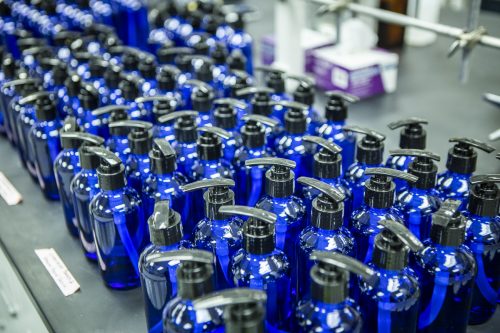Chemistry department mobilizes to produce hand sanitizer for hospital
May 6, 2020
Tanya Clayton
907-474-7541
The University of Alaska Fairbanks Department of Chemistry and Biochemistry has teamed
up with Fairbanks Memorial Hospital to produce hand sanitizer.

The chemistry laboratory in the College of Natural Science and Mathematics' Reichardt Building is putting its quarantined facilities to good use. Normally bustling with student activity, the area is instead being used to produce hand sanitizer, which Fairbanks Memorial Hospital is running in short supply of.
Gwen Holdmann, director of the Alaska Center for Energy and Power, serves on the UAF COVID-19 support team, which meets every other day to research and discuss community requests for support. One that came up almost immediately was from the Fairbanks Memorial Hospital. They were quickly running out of hand sanitizer, and to make matters worse, it was on backorder.
“I shot off an email to almost everyone I knew, which ballooned into this response, and we were able to turn things around very quickly,” she said.
That’s when the CNSM laboratory and two UAF chemists came into the picture.
“The hospital was needing help, and Hoarfrost Distillery had been working at getting the formulation right,” said Emily Reiter, lab and safety coordinator for the Department of Chemistry and Biochemistry. “We said we’d be happy to help.”
Reiter said she got the request on March 30, and after numerous conversations with attorneys, the mayor’s office and various state offices, the laboratory is now approved to produce hand sanitizer.
Teri Kiss, chief quality officer for FMH, estimates they go through well over 10 liters of sanitizer a day.
We go through it like crazy,” she said. “It really is an essential supply.”
The process began with an FDA-approved formula, which FMH passed on to Reiter and fellow chemist Arianna Demmerly. Ethanol or isopropyl alcohol is mixed with hydrogen peroxide, glycerin and distilled water.

Even though there are many formulations available online, it is important to make sure such preparations are safe to use on human skin.
“We’ve got to make sure we get it right, because these workers are depending on us,” said Tracey Martinson, acting director for Environmental Health, Safety and Risk Management at UAF.
Bottles were rounded up and donated by UAF and Sunshine Health Foods.
Both Reiter and Demmerly were happy to be part of the COVID-19 response team, and were pleased that the collaboration would immediately benefit first responders in the Fairbanks area.
Reiter also sees the impact this project could have, in teaching prospective students.
“I’ll be using lessons about the formula calculations in a future general chemistry class. That way, our students can be ready, because as we can now see, it has real-world application,” she said.
For more information, contact Tanya Clayton, public information officer for the College of Natural Science and Mathematics, at 474-7541 or tfclayton@alaska.edu.


